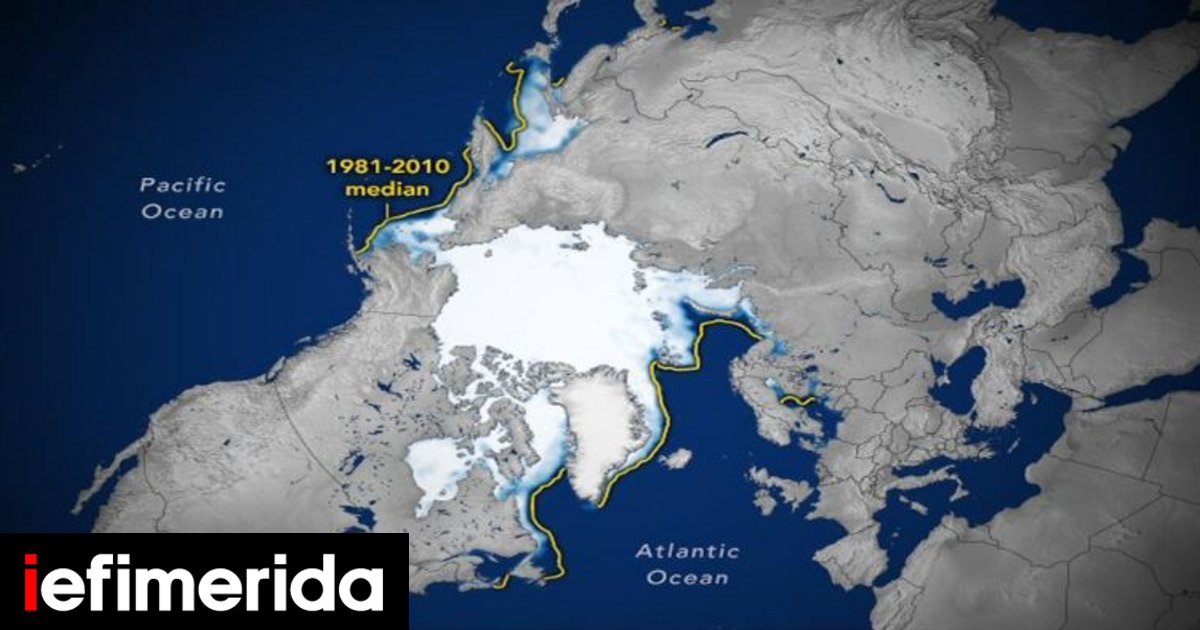
Sea ice continues to shrink in the Arctic Ocean, and the numbers are alarming according to EMY Director Theodoris Koulidas.
In particular, meteorologist Mr. Koulidas noted on his personal website that Arctic sea ice “continues to shrink and weaken through 2024. The maximum winter ice cover in the Arctic Ocean corresponds to a 46-year-long decline.”
Todoris Koulidas posted in detail
Analysis of satellite observations revealed that the total area of the Arctic Ocean covered by sea ice reached 6 million square miles (15.65 million square kilometers) on March 14, according to NASA. This means that there is 247,000 square miles (640,000 square kilometers) of ice below the average maximum extent between 1981 and 2010. Overall, the maximum Arctic winter ice cover has decreased by an area the size of Alaska since 1979.
The map above shows the extent of ice on March 14, the annual maximum day. To determine the extent, scientists project satellite observations of sea ice onto a grid, then sum the total area of each cell that is at least 15% covered by ice. The yellow chart shows the average February sea ice extent from 1981 to 2010. The average is the median value, meaning that half of the extents were greater than the yellow line and half were less
The analysis is based on data collected by microwave sensors on the Nimbus-7 satellite, which is operated jointly by NASA and the National Oceanic and Atmospheric Administration (NOAA), along with satellites in the Defense Meteorological Satellite Program.
This graph shows the daily extent of sea ice by mid-March 2024 (red) compared to the record low of 2017 (orange) and the average range from 1981 to 2010 (blue). This year's Arctic sea ice maximum is the 14th lowest on record. Complex weather patterns make it difficult to predict what will happen in any given year. Scientists at NASA and the National Snow and Ice Data Center (NSIDC) at the University of Colorado, Boulder, monitor these seasonal and annual changes because sea ice shapes Earth's polar ecosystems and plays an important role in global climate.
“The sea ice and the snow above it are very reflective,” said glaciologist Lynette Boisvert of NASA's Goddard Space Flight Center. “In the summer, if we have more sea ice, it reflects the sun's radiation and helps keep the planet cool.” Conversely, shrinking ice makes the Earth more susceptible to solar heating. The exposed ocean is darker and absorbs solar radiation more easily, capturing and storing this energy and ultimately contributing to the warming of the planet's oceans and atmosphere. Sea ice around the poles is more sensitive to weather conditions than it was a dozen years ago. Ice thickness measurements collected by laser altimeters on NASA's ICESat-2 satellite show that less ice manages to survive the warmer months. This means that new ice has to form from scratch every year, rather than building on top of old ice to form thicker layers. Thin ice, in turn, is more vulnerable to melting from multi-year accumulations.
“The thinking is that within a few decades, we will have essentially ice-free summers,” Boisvert said, with the ice cover reduced to less than 400,000 square miles (1 million square kilometers) and most of the Arctic Ocean exposed to warm sunlight. It shines.
Source: NASA Earth Observatory I.

“Total alcohol fanatic. Coffee junkie. Amateur twitter evangelist. Wannabe zombie enthusiast.”





More Stories
Is this what the PS5 Pro will look like? (Image)
Finally, Windows 11 24H2 update significantly boosts AMD Ryzen – Windows 11 performance
Heart Surgeon Reveals The 4 Things He ‘Totally Avoids’ In His Life